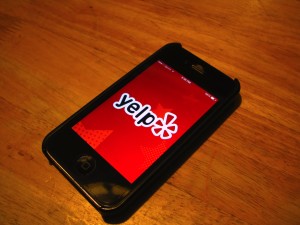 You just had a great meal at a restaurant. So you grab your phone and fire off a glowing review on Yelp.
You just had a great meal at a restaurant. So you grab your phone and fire off a glowing review on Yelp.
Consider the opposite scenario: You just had a horrible meal at a restaurant. So you grab your phone and fire off a scathing review on Yelp.
Now here’s one more: You had a great meal at a restaurant but woke up vomiting the next morning. Do you grab your phone and fire off a complaint on Yelp that your dinner made you sick?
That’s what a trio from Boston Children’s Hospital’s Informatics Program, are banking on.
A report in Preventive Medicine, authored by John Brownstein, PhD, Elaine Nsoesie, PhD and Sheryl Kluberg, MSc, judges Yelp’s usefulness as a food poisoning surveillance tool. Their efforts are part of a growing trend among public health researchers of trying to supplement traditional foodborne illness reporting with what we, the people, say on social media.
It’s estimated that some 48 million Americans get food poisoning every year, but that number is likely far off the mark. “Foodborne illness is under-reported, under-documented and hard to get at,” says Brownstein, who co-founded the HealthMap epidemic tracking tool and who also has a data grant from Twitter focused on foodborne illness.
Part of the problem is that food poisoning sufferers may stay out of work or school but aren’t sick enough to visit a doctor or hospital. It’s those medical interactions, though, that would normally trigger reports to and inspections by local public health authorities.
Brownstein sees a better way: “Social sources can provide a new view of what’s happening that wouldn’t come through official channels.”
Yelping about being sick
As a proof of concept, Brownstein, Kluberg and Nsoesie used a sample data set from Yelp—5,824 restaurant reviews from 29 localities between 2005 and 2012—to identify and characterize possible food poisoning events. In particular, they wanted to see if the foods implicated in disease reports made sense, given the known common sources of foodborne illness (dairy, meat, fish, etc.).
Social sources can provide a new view of what’s happening that wouldn’t come through official channels.
The categories of foods people blamed on Yelp did match data from the U.S. Center for Disease Control and Prevention’s (CDC’s) FOOD (Foodborne Outbreak Online Database) system very closely. For instance, 16 percent of the Yelp complaints mentioned seafood, compared to 12 percent of reports in FOOD. Similarly, meat or poultry stood out in 32 and 33 percent of Yelp complains and FOOD reports, respectively.
What surprised the team, though, was the overall number of people who announced on Yelp that they’d gotten sick after eating out. Nearly 10 percent of the restaurant reviews in their data set mentioned a food-related illness.
Nsoesie chalks this up to the nature of social media. “We think most of the people who reported being ill on Yelp would probably not submit reports to public health authorities,” she says. Brownstein agrees, adding that he thinks people are likely to turn to social media because they want the restaurant and other diners to see their concern.
Going (stomach) viral
Nsoesie, Kluberg and Brownstein may not have had the data to able to validate their Yelp complaints against state or local health department reports, but they aren’t alone in trying to mine social media for better food poisoning reporting. Chicago and New York City currently have programs in place to monitor Twitter and Yelp, respectively.
Both programs use machine learning to sift tweets or reviews for keywords like “food poisoning,” “vomit” or “diarrhea” and flag any matching reports for closer examination by a human. Reports that make the cut trigger a call or tweet asking for more information. Inspectors can then check the implicated restaurant.
 “Chicago’s health department was really the first to come up with the idea of crowdsourcing food poisoning reports,” Brownstein says, adding that he and Nsoesie are now working on a similar system for Boston-area public health officials.
“Chicago’s health department was really the first to come up with the idea of crowdsourcing food poisoning reports,” Brownstein says, adding that he and Nsoesie are now working on a similar system for Boston-area public health officials.
Both the Chicago (called Foodborne Chicago) and New York programs each recently published papers in the CDC’s Morbidity and Mortality Weekly Report outlining their initial experiences and outcomes (you can read the New York report here and the Chicago one here). Of note, the New York program identified three outbreaks using Yelp data that otherwise would have been missed.
If you build it, they won’t necessarily come
Brownstein sees certain advantages to this social-media-scanning strategy over creating a dedicated public reporting tool.
“We want to go where people are already,” he explains. “People want to engage on social networks, so it’d be better for us to go those places, utilize those data and reach back if we need to as opposed to building more siloes.”
Jay Bhatt, DO, the Chicago Department of Public Health’s chief innovation officer, echoes that observation in describing Foodborne Chicago’s origins. “Our commissioner recognized that people weren’t necessarily communicating with our 311 system about the potential exposures. Given the power of social media, we asked whether we could use it in a way that would complement residents’ engagement with city services.”
“It’s about meeting residents where they are,” adds the Chicago health department’s Raed Mansour, MS, who with Bhatt helped bring Foodborne Chicago into being, “instead of trying to send them to someplace else they’re not used to.”
Brownstein sees social media as one way of helping fulfill a larger obligation in public health.
“If people are complaining and have health issues, and those issues could potentially impact a broader population, there’s a responsibility to figure out ways to utilize that data and to investigate.”







